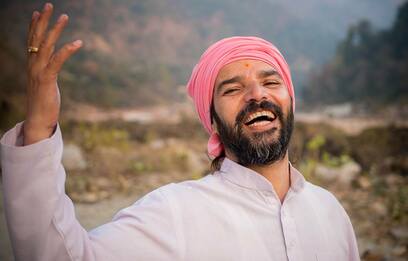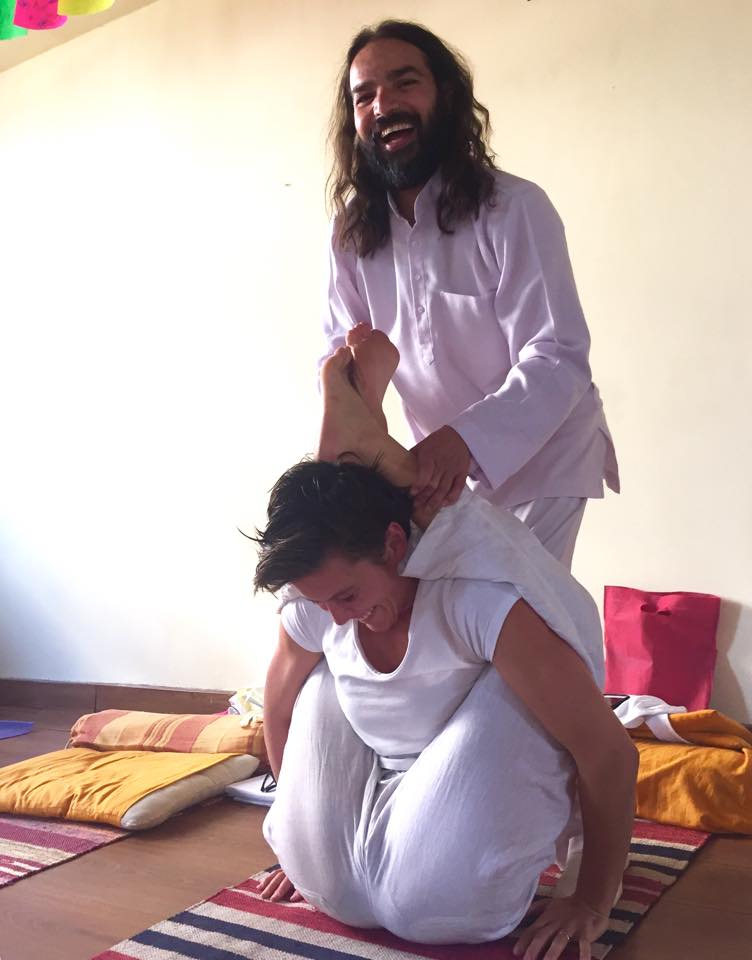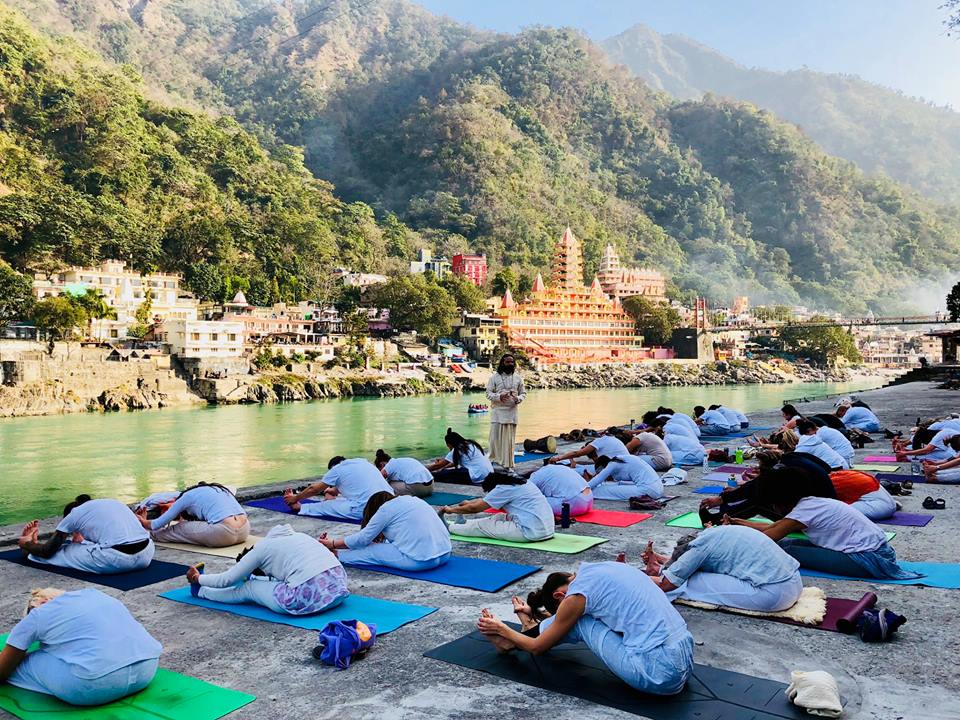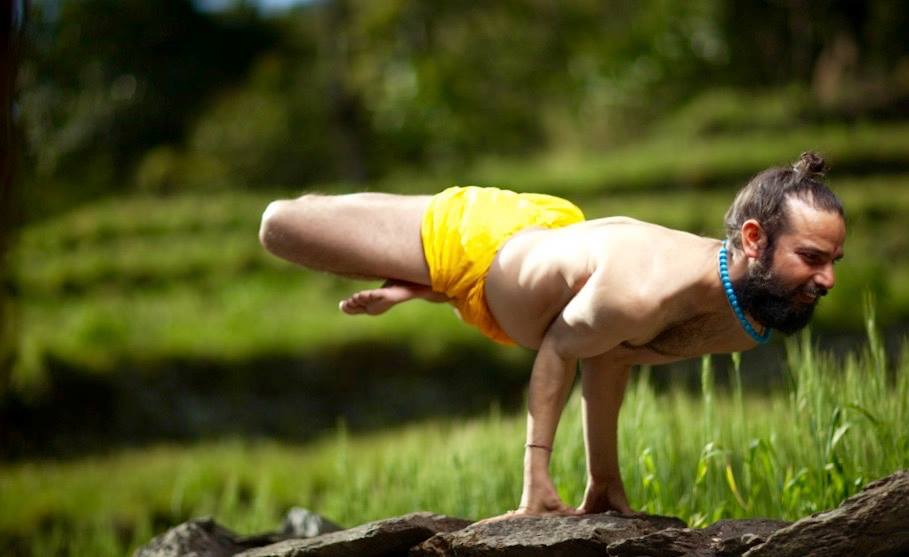Yogi Vishvketu: "I’m not looking for any enlightenment or anything. I’m just looking to be normal, that’s it"

If you're looking for a unique yoga style, check out this interview with Yogrishi Vishvketu, the founder of Akhanda yoga style. Akhanda yoga cultivates many hatha yoga practices that are rarely present in contemporary yoga studios. Vishvketu incorporates many techniques from traditional yoga, sukshma vyayama and kundalini into the sequence, but some of the dynamic pranayamas combined with asanas are unique to this style.
TopYogis: Please, tell us about your personal journey with yoga, how it all started?
Yogrishi Vishvketu: Namaste. My journey started since my childhood, at a very young age. So many techniques and practices I just knew and no one taught me. When I was 6 years old, I ran away from home to become a yogi. My parents did not know anything and they were looking around all the village, they were a little bit worried. What’s happened? I went to the Swamiji, a yogi, and I asked to wear an orange clothing. So he gave me some sweets and one glass of milk. And I was sitting there for 2 hours, and then he told me: “You are a little bit too young to wear orange clothing”. Then he sent me back with his another disciple, and then I went home. So my parents and neighbors were very surprised, and they were not very happy. But they did not stop me from what I wanted to do.
So when I was 8 years old, I wanted to go to the traditional ashram to learn yoga - in Kanvashram. And that ashram is in the forest, you have to take care of yourself. So my parents did not want to send me there because in the forest there are all kinds of animals, wild animals, scorpions, snakes, panther, elephant, pig, bear - all wild animals of the jungle. So they did not want to send me there. But I kept crying: "I want to go there, I want to learn yoga”. And they tried to convince me “You can learn yoga here”, and all kind of things. But I wanted to go, get out from the home. And then finally they sent me there. They told me: “If you do 8 days, take care of yourself in the home”, they gave me a plate, my clothes, my box. “You have to take care of yourself for 8 days. If you have done well, then we will send you”. So I had to wash my dishes, clean my clothes, folding them and putting in the box and things. Just basic things of taking care of the child. So I did it all myself for 8 days and then they realized: “You can’t hold him here”. So then finally they sent me to the Gurukul, where I learned the traditional way of yoga practice, and I was 8 years old. So that’s how my formal training, formal yoga studies started.
TopYogis: And you spent there a long time?
Yogrishi Vishvketu: I spent a long time, and then I started my graduation in the yoga, and then Master degree in yoga, and then PhD in yoga too.
 TopYogis: Vishvketu Ji, what is for you the purpose of yogic practice?
TopYogis: Vishvketu Ji, what is for you the purpose of yogic practice?
Yogrishi Vishvketu: Just to be normal (laughs). Being a normal means you are blissful, happy, expandable. That’s the normal state for a human.
TopYogis: But not too very often seen out there, this normal state.
So, my purpose of doing yoga and teaching yoga is to be normal, and to make people normal. And normal means for me blissful, expandable, playful, fearless, creative, loving, kind human being. And that’s it. I’m not looking for any enlightenment or anything. I’m just looking to be normal, that’s it.
TopYogis: Tell us about your Akhand yoga.
Yogrishi Vishvketu: Akhand yoga is the yoga practice. In it, five things are involved as we teach. One is philosophy, and each class has a theme. The second thing is asana, the third thing is the breathing - pranayama, the fourth thing is the sound work - chanting mantras, and the fifth is meditation. So these are five very important things, and you can’t separate them in yoga practice. So, in Akhand yoga classes, we teach five things in the same place, and that’s working. Because sometimes people are just doing asana, that is incomplete. Some people are just doing the sound work, that’s also incomplete. Some people are just sitting in meditation - that’s also not getting deeper without asana, or breathing, sound work or philosophy, without intention. Or people are doing yoga and have no intention. So, these things you can’t separate from yoga. So that is “akhand”.
Akhand means unbroken, whole, the feeling full to yourself and connecting to everyone and to the higher self. That’s the Akhand.
TopYogis: This is a very busy world now, very fast. And sometimes people come and ask funny questions, so we have a funny question for you: what would you tell a person who says: "Guruji, I have only fifteen minutes a day. What can I do in these fifteen minutes?
Yogrishi Vishvketu: Do the honeybee. If someone has only fifteen minutes, it means that this person is very stressed. That means that the stress goes into the cellular level. So begin with the brahmari, honeybee sound. That will release stress from the cellular level, and just make them little normal. When they are normal, they will not be running around, then they will have more time to do practice.
TopYogis: Vishva-Ji, what is your personal practice?
Yogrishi Vishvketu: My personal practice starts at 3:30 AM. First, I do purification, jala neti, lubrication of nostrils, sometimes I drink water and throw up, and sometimes I eat the tiny cloth and take it out - purification of my physical body. Then I do my self-massage. Body massage. Oil lubrication, joints, muscles, circulation, it’s really good for your skin. And then I do my five things together: chanting, movement, breathing, meditation, and philosophy things. So I do my whole Akhand yoga practice, and then after the meditation, I take a cold shower. And after that, I am ready to teach my morning class. At 6 AM I am ready for my day.
So my day begins at 6 AM. Before that is my time.
As a yoga master, you must have your time to yourself, every day, before you give to someone. You need to recharge yourself, re-inspire, reopen, reconnect, otherwise you just become an instructor. Just you say things, but they have no value in it.
So yoga for me is a journey, and as a yoga master, it’s a journey with practice and a student. It’s a journey together, the student and the teacher go together in the same train.
TopYogis: In your long yoga practice, have you had any yoga-related injuries? Anything that happened for some reasons that maybe people should be aware of when they practice?
Yogrishi Vishvketu: I love that question (laughs). Yoga is a healing system. And if in this healing system I get injured, it means I’m not doing the right thing. It means I am missing something. I am missing intention, or I am doing with the wrong intention. So, yoga is a healing process. And that should not injure you. Unless you are doing totally out of the intention, or you are doing the wrong practice, the wrong way. That’s where people are getting injured.
And I just laugh when people say: “I was doing yoga and I got injured”. It means you are not listening. You are not listening to the message that your body is trying to send you. It means that teacher has not given the proper guidance to you. It means you are not in the proper alignment. I am not just talking physical alignment, internal alignment.
So people get injured. But if you do yoga, you should not get injured. You should get healed. Every class should be healing.

TopYogis: Vishvaji, what do you think about headstand? We ask this question because in the west there is a controversy. Some teachers don’t practice headstand and don’t teach it also, and some teachers think that it is the best asana. So we want to know your opinion.
Yogrishi Vishvketu: Yes, for headstand, I really like headstand. If you do it in the right way, it has so many benefits. But if you don’t know how to do it in a right way, it can harm you. Especially sometimes when people try the headstand, they bounce off the ground, head on the ground, trying to bring the legs up. Most of the time, their neck muscles, their physical body is not ready to do it, because these neck muscles hold only 10% of the body weight in the head, and they are now putting 90% weight on them. They are capable to hold 90% weight of your body, but you need to prepare for it. You need to train them. But if there’s no training, it can be very harmful to the people, especially in the neck area.
Instead of doing the headstand, you can also do the shoulder stand, sarvangasana. Both poses are really good. If you are ready to do the headstand, and you have prepared yourself - yes, you go ahead to the headstand. And if you’re not ready, physically or emotionally, and you like to do the sarvangasana - inversion pose, that’s very important for you.
Inversion poses, what do they do? Headstand, sarvangasana and handstand all are inversion poses. Inversion poses work on your pineal and pituitary glands, or if I call it in yogic terms, they work on your Udan prana. And those glands - pineal and pituitary - help to concentrate, improve endorphine hormones to make you happy. Udan prana helps you in concentration. It also helps you to go to deeper sleep. Udan prana is helping you to be aware of your senses. It works with the five senses.
So for me, inversion pose is a very important pose. It can be headstand, or it can be a shoulder stand or a handstand - in your asana practice there must be inversion pose. It’s more “inversion pose” instead of a headstand, a shoulder stand, etc. You can pick according to what your body is ready for.
TopYogis: Vishvketu Ji, would you have any advice for people coming from far away to Rishikesh to find some yoga, and they come and there’s so much here. What should they do? It’s difficult to figure out right away what would be a good teaching for a person.
Yogrishi Vishvketu: Good luck with that, with finding a right teacher. It is true, finding a right teacher, if you have a good luck - that’s it. Not just in Rishikesh, all over the world. And all traditional books say: If you are lucky, you can find and meet the right teacher, right guru. Otherwise, just it’s harder to find. And if you are ready, you will find the right teacher. If the student is ready, they will find the right teacher.
TopYogis: Thank you so much!

You can contact Yogi Vishvketu and see where and when he is teaching at his TopYogis page. If you have practiced with him you can share your experience there.
Find Akhanda yoga teachers in Rishikesh
Find Akhanda yoga instructors around the world.
Find yoga teachers in Rishikesh (all styles)
Find yoga schools in Rishikesh.

pretoum
The family of Henrietta Lacks, a mother of five who died from an aggressive form of cervical cancer at Johns Hopkins Hospital in 1951 and whose harvested cells have paved the way for countless medical breakthroughs in the past 62 years, will have a say in how those cells are used in the future 36 hour cialis online Although medial areas were not different among males, vehicle treated females, and 17ОІ E 2 supplemented females, neointimal area and intima to media ratios were greatest in the male